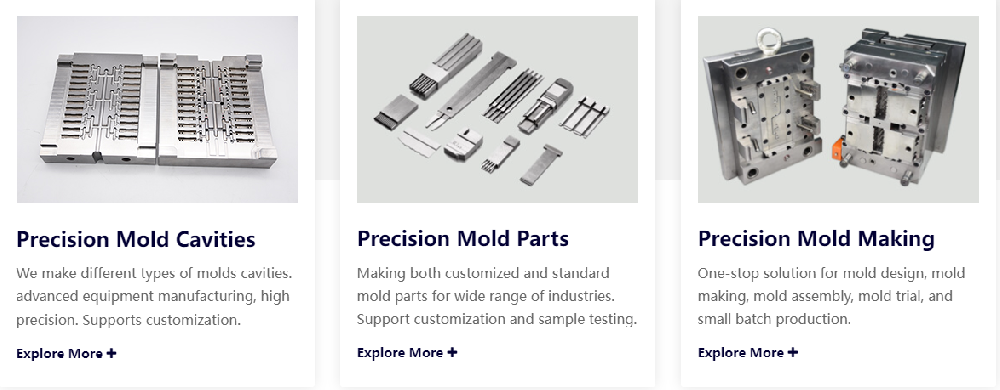
Injection mold processing, precision mold processing
Plastic mold production involves multiple processes, including blanking, processing cavities, cores, etc. After production, polishing, assembly and mold testing are required. Injection mold processing uses CNC machine tools to perform fine processing on the designed mold. The materials are divided into soft molds and hard molds, and aluminum alloy 6061 is commonly used for processing. The processing accuracy requirements are lower than those of stamping molds, and slow wire processing can achieve high precision.

1. What are the processes for making plastic molds?
1. If there is a ready-made mold template, you only need to process the cavity and core, and the fitter will make the holes for assembly. If everything starts from scratch, you have to start cutting, milling, planing, grinding, the shape of the template, and then start processing the cavity, core, etc.
2. The process of making plastic molds is as follows: During injection molding, the mold is clamped on the injection molding machine, the molten plastic is injected into the molding cavity, and cooled and shaped in the cavity. The upper and lower molds are separated, and the product is ejected from the mold cavity by the ejection system. The mold is closed again for the next injection molding, and the entire injection molding process is cyclical.
3. Polish the runner surface to increase the surface finish; 1 Check before assembly and do a good job of cleaning and rust prevention; 1 Assemble the injection mold; 1 Test the mold, debug it without any problems, and a pair of molds is completed.
Generally speaking, the production time of injection molds is related to the size and complexity of the product. The cycle is usually 15-20 days, and the fastest test plate for mobile phone molds is 7 days.
4. Finishing - EDM: Use the principle of EDM erosion to process the fine parts of the mold. - CNC milling: Use CNC milling machines for high-precision cutting. Grinding Use a grinder to grind the mold surface to the required accuracy and finish.
5. Mold adjustment and trimming According to the results of the trial mold, make necessary adjustments and trimming to the mold to ensure that it meets production needs. 1 Surface treatment Such as coating, painting, etc., to improve the corrosion resistance and surface texture of the mold. Conclusion Plastic mold making is a complex and delicate process involving a variety of technologies and processes.
6. It is best to mark the part number, name, material, material shrinkage, drawing scale, etc. under the process diagram. Usually, the process diagram is drawn on the mold assembly drawing. The mold assembly drawing should include the following: The structure of the mold molding part The structural form of the pouring system and the exhaust system.
2. What machine is used for injection mold processing
1. Injection mold processing is completed by CNC. After the workpiece is clamped once on the machining center, the digital control system can control the machine tool according to different processes, automatically select and replace the tool, automatically change the machine tool spindle speed, feed rate and tool relative to the workpiece movement trajectory and other auxiliary functions, and complete the multi-process processing on several surfaces of the workpiece in sequence.
2. Injection mold processing is mainly for the fine processing of the designed mold, usually for the production of samples or small-scale injection molded parts, and does not involve the mold design and manufacturing links. Machining equipment, such as CNC machine tools, is required during the processing to accurately process the shape, hole position, angle and other details of the mold.
3. Injection molds are also divided into soft molds and hard molds in terms of materials. Soft molds are generally made of P-20 pre-soft steel, and some positions are made of carbon steel above No. 45; hard molds are made of hot-working mold steels such as H-13 (manganese steel) or 420 (stainless steel plate).
4. 6061 aluminum alloy: 6061 aluminum alloy is an aluminum alloy material commonly used in injection mold processing. It has good processing performance and high corrosion resistance, and is suitable for the production of small and medium-sized injection molds.
5. In the manufacture of injection molds, common applications include insert holes, ejector holes, inclined ejector holes, cavity corner cleaning and slider processing. Generally speaking, the processing accuracy requirements are not as high as those of stamping molds. Slow wire processing is a high-precision processing method. High-end machine tools can achieve a processing accuracy of less than 3μm, and the surface roughness can reach Ra05μm.
Recommended reading
- -"5 Secrets to Perfect Mold Parts Every Time – #3 Will Shock You!"
2025-02-11 - -Injection mold processing, precision mold processing
2024-12-26 - -Why buy precision Injection Molding Spare Parts in China?
2024-12-16 - -Components of an Injection Mold
2024-11-25 - -High Precision Core Insert for Plastic Injection Mold
2024-11-05 - -What are the key steps in heat treatment and surface treatment of molds?
2024-10-31 - -Precision irrigation system mold cavities and mold parts play a crucial role in the manufacturing
2024-10-31 - -How to control the roundness and cylindricity of precision parts machining
2024-09-26 - -Definition and production of mold cavity in casting
2024-09-24 - -OKMOLD has a new look! Discover it at FAKUMA 2024
2024-09-23
